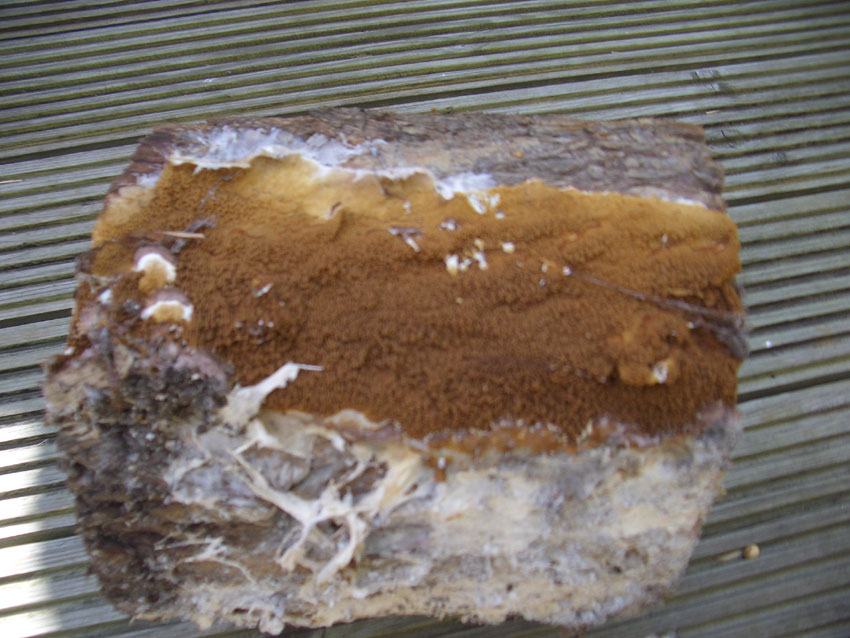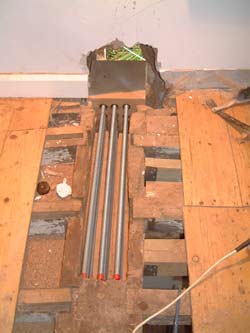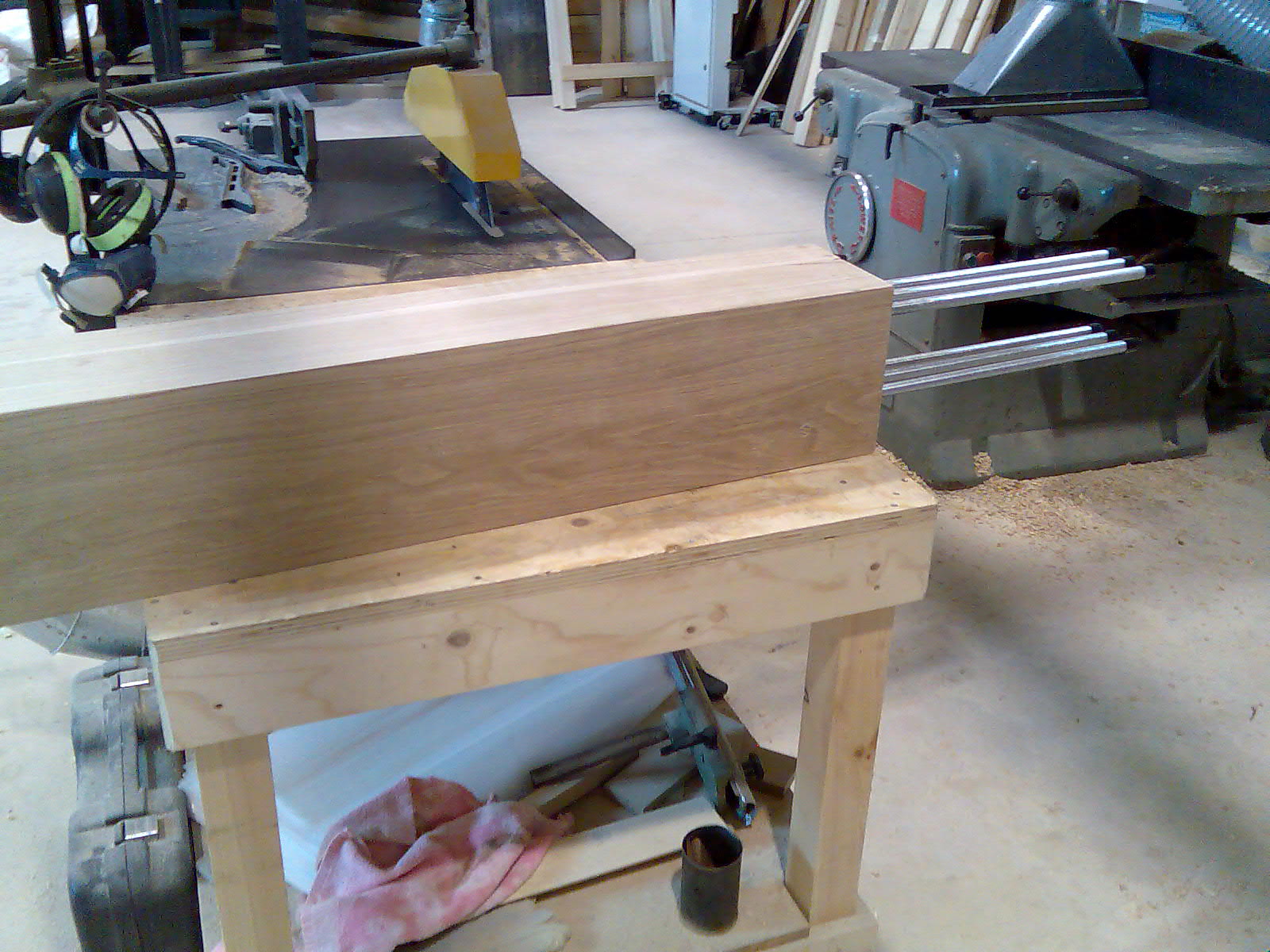Matching Timber Species:
A repair using matched Oak for a 'sympathetic' appearance
Treating the Rot -
Boron to the rescue
When the moisture content of a typical softwood rises above 18 - 20% it becomes vulnerable to decay by wood rotting fungi. The wood boring insects also prefer damp timber - they specialise, like the rots, in converting wood back to its constituent parts to become nutrient in the soil for new growth and they cannot distinguish between your house and the forest floor.

Fruiting Body of Dry Rot with Mycellium
To prevent this natural process from occurring we try to keep timbers dry and in many cases we purchase them pre-treated with 'poisonous chemicals' (like C.C.A. - copper, chrome, arsenic) incorporated as preservatives.
However, old building timbers were not preservative treated and even modern pre-treatment has a limited life, so in the end all wood becomes prone to decay if it remains at a high moisture content for an extended period (years).
To prevent decay, or stop an existing attack, we simply need to introduce the correct amount of a Boron based compound, D.O.T., into the wood. This chemical has very low human toxicity and can be applied as a surface liquid or gel, or as an injectable paste, or inserted into drilled holes as a solid soluble rod. The active ingredient spreads inside the timber and protects it from rot and insect attack.
This method is widely used in the Electricity Supply Industry, for the treatment of wooden transmission poles. Such poles were originally pressure treated with creosote, but as cracks and splits open up the timber surfaces due to the action of UV light and rainwater, wood rotting fungi and wood boring insects begin to penetrate beneath the creosote layer. To combat this problem the Industry has a policy of Boron maintenance - the injection of Boron-based Paste and the insertion of Boron-based rods. This combination adds many years of service, massively reducing decay and pole replacement costs.
David Moore
Property Repair Systems
Resins - some background information - how we use them
Timber-Resin Repairs - how the Structural Calculations are made
Guarantees - who Guarantees what?
Chris Barratt
Isca Preservation
Structural Timber Beams - repairing the rot with the minimum loss of original wood
Posts and Legs - how a Cupola was repaired in Devon
Curved Beams - clever use of simple techniques to restore lintols
Matching Timber Species - a repair using matched Oak for sympathetic appearance
Missing Sections - shuttering and pouring - resin repairs with bars
Photographs:
Copyright Chrs Barratt
References:
T.R.A.D.A. Eurocode 5
Resin Repair Systems
www.trada.co.uk
Structural Calculations
The Straight Line Theory of Elasticity
Suggestions:
Would you like to see your Project printed here? Would your Company like to Sponsor an edition of the Timber Repair Review?
Contact David Moore, the Editor at dcmoore@timber.org.uk
Tel: 01626 872886
About the Timber Repair Review:
An independent technical publication aimed at presenting topical analysis of all timber repair and treatment techniques for the use of Architects, Structural Engineers and other interested professionals in the building refurbishment industry.
David Moore, Editor
Property Repair Systems
Tel: 01626 872886
E Mail: dcmoore@timber.org.uk
Using the Patented Timber-Resin Splice technique allows us to fit a new bearing end onto an existing timber in a matching species - for example Oak, Douglas Fir, Pitch Pine or even Elm.

New TRS Bearing End in place
In this example an Historic Building had suffered from wet rot and Death Watch Beetle inside the original Oak bearing ends of the main floor support Carrier Beams.
Once all the decayed wood has been dug out of the wall the remaining timber skin can be cleaned up for connection to the new part. This new part, a Timber-Resin Splice made in Oak, is fitted with bars or made with slots, ready to connect to the 'parent' beam.
The connection is made using high tensile zinc plated steel allthreaded bars and these bars are then covered in Structural Epoxy Pouring Resin. This resin is self levelling and highly 'seeking' - it will even pass through a pin hole. This ensures a full bond to timber and steel.
The combined composite is capable of carrying the full original load capacity of the beam, plus a safety margin.
The new, beautiful Oak end can be chamfered, stained or painted to match the original, or left as an 'honest' repair for all to see.

Oak Timber-Resin Splice in build
Because most timbers, including Oak, cannot be obtained in Kiln Dried condition above 3 inches (75mm) in thickness, all repairs for indoor use are laminated.
In practice, by the time that the Oak has been machined flat for lamination, we can rarely achieve laminations thicker than 70mm. In Softwoods we can obtain dried timber up to 100mm thick.
The virtue of laminating Kiln Dried timber is that it will be stable when installed in a centrally heated environment.
The essential requirement is to match the expected humidity of the intended location of the repair. So, for example, a repair to an outdoor porch roof timber would use Air Dried Timber (typically 15% to 16% total moisture content), whilst a repair to a decorative beam across a living room would normally use Kiln Dried Timber (typically 10% to 12% total moisture content).
In both cases we need stability - minimum twisting and splitting.
If 'green', unseasoned timbers were used in a low humidity, high temperature environment (like a domestic living room) the amount of movement could be considerable, potentially endangering the resin connection and any abutting structures, pipes and wiring.
Freshly felled, or 'green' timber, is not really suitable as a building material where modern fit and finish is required - though fashionable, it causes many problems when it moves and shrinks during the natural drying process, so we rarely use it in repair work.
In modern buildings, where extensive use is made of Kiln Dried timbers, some drying out will still take place in the first few years after construction and it is common to see skirting boards and architraves with splits and gaps open up around plaster and mortar. Noisy flooring is also caused by shrinkage, hence the most recent move to man-made composite timbers, made from timber waste, such as Paralam and fabricated joists constructed from board or ply products, but incorporating metal webs.
For historic or valuable timbers the repair of choice is the Timer-Resin Splice, using a new component made from Kiln Dried matching timber, laminated to exact size.
Timber Species
Most original timbers can still be purchased today - oak, elm, Douglas fir, pitch pine and so on - but not in the section sizes used in historic buildings.
In the past the large timbers were 'seasoned' - air dried. This process takes many years and requires a massive investment. Use of unseasoned timbers in times of war, when building sailing ships, caused huge problems, including Dry rot during building and hull failure once launched.
Today we Kiln Dry timber, also at great expense, in gas or oil fired ovens. This takes only weeks, rather than years, but the rapid heating and drying destroys a percentage of the timber kilned and maximum timber thickness is reduced to 3 to 4 inches, depending on Species.
The thicker the wood that is Kiln Dried the larger the splits that result and the more costly the losses.
Exactly the same process occurs naturally, in service. The centre split along a timber is known as a 'shake'.
Carrier beam with central 'shake'
Boron Safety
The toxicity of D.O.T. is so low that many of its formulations are not rated as hazardous at all - very few products have a safety record going back to the 1880's and yet are still in huge demand today for their unbeatable versatility.
D.O.T. is also referred to as 'Timbor' and 'Polybor' and it is frequently specified for the preservation of Electricity supply poles, railway sleepers and wooden window frames. Its full chemical name is Disodium Octaborate Tetrahydrate and should not be confused with any of the other Borates (oxides of Boron) commonly and confusingly referred to as 'Borax'.

Boron Rods in packets of 10 - sizes from 8mm +.
Boron Rods can now be Specified as part of new joinery, for insertion during manufacture. They are commonly offered in window frames and timber structural framing, positioned at the vulnerable joints.
Once placed inside the wood the Boron Rods and Boron Paste slowly dissolve and spread their preservative effect in all directions. In softwoods that spread can exceed 75mm across the grain and over 120mm along the grain. The protected zones are then invulnerable to decay from rots and insects.
Boron History
Compounds of Boron, known as Borates, have been mined since the 1800s and have been used to control insect pests and wood rotting fungi for over 100 years.
By the 1940s borate formulations were commonly being used to protect wood. Because they are water soluble, Borates diffuse into wood using the wood's own moisture (even 'air dry' timber has a moisture content of 12-15%) and they protect against termites, wood destroying beetles, carpenter ants and fungi, including Dry rot. 'Borax' the Company is now owned by Rio Tinto, the mining conglomerate.